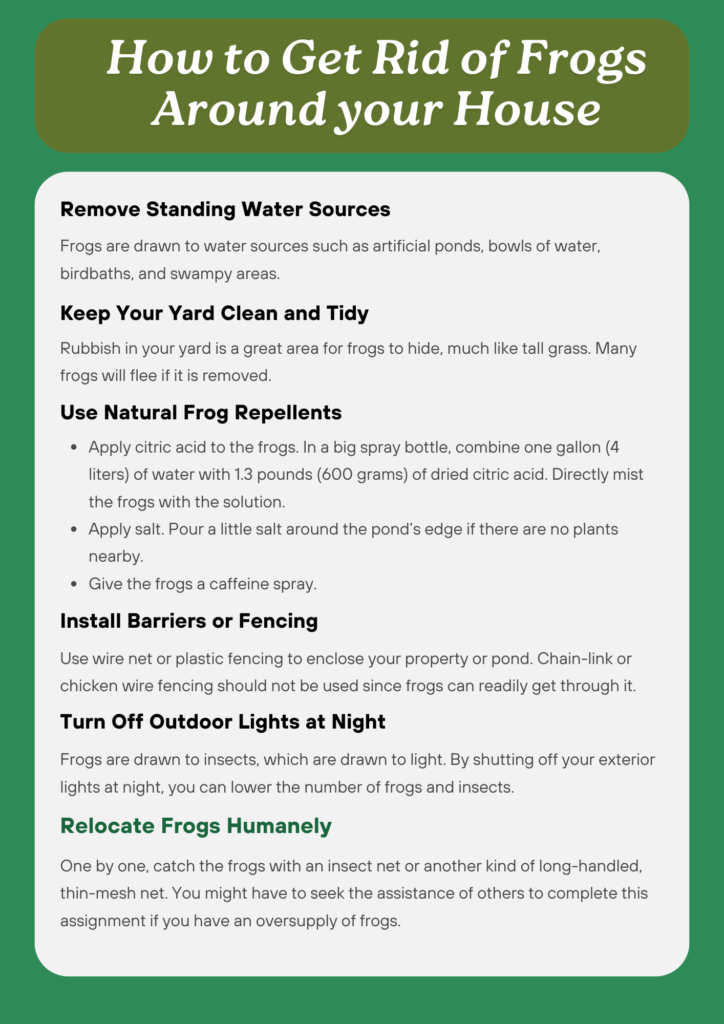Learn how to get rid of frogs around your house with these simple, humane tips. Remove standing water, use natural repellents, and keep your yard clean for a frog-free home. If you’re wondering how to get rid of frogs around your house, here are some effective and humane methods to keep them at bay.
How to Get Rid of Frogs Around your House
Let me share the step by step guide so you can get rid of frogs around your house.
1. Remove Standing Water Sources
Since frogs are drawn to wetness, most of them will become disinterested and go for another location for laying their eggs and take cover at night if you remove any water sources from your yard. To remove the majority of water sources, you may rent a pump.
Frogs are drawn to water sources such as artificial ponds, bowls of water, birdbaths, and swampy areas.
Eliminating sources of standing water will help deter mosquitoes and other frog-eating insects, thus diminishing the area’s appeal.
Try installing a filter or an operating fountain to your natural pond if you want to keep it as your yard’s water source. The water will circulate as a result, getting rid of the majority of mosquitoes and other insects. Even while the frogs continue to draw their attention to the water, many of them might decide to leave if the food supply declines.
2. Keep Your Yard Clean and Tidy
Rubbish in your yard is a great area for frogs to hide, much like tall grass. Many frogs will flee if it is removed. Eliminate any structures that could provide a damp, dark hiding spot for frogs, such as old timber, masses of chipped wood, or empty pots.
3. Trim Overgrown Vegetation
For frogs, tall grass, plant life, or other bushy vegetation are ideal hiding places. When these things are removed, the frogs are forced to be revealed, which is something they usually strive to avoid. It is particularly problematic to have tall plants near a water supply. Place tall or bushy plants far away from any source of water as you can if you want to keep them in your yard.
4. Use Natural Frog Repellents
Frogs can be effectively killed or repelled from an area by a few natural compounds. Before employing a chemical spray, try utilizing one of these materials, as chemical-based sprays usually to harm the frogs gradually. In general, organic sprays are more efficient and gentler.
Apply citric acid to the frogs. In a big spray bottle, combine one gallon (4 liters) of water with 1.3 pounds (600 grams) of dried citric acid. Directly mist the frogs with the solution. They should be killed nearly instantly.
Apply salt. Pour a little salt around the pond’s edge if there are no plants nearby. The frogs will avoid the area since the salt will burn their toes. However, keep in mind that salt will kill plants.
Give the frogs a caffeine spray. Concentrated caffeine will kill frogs by making them have heart attacks, but you can discourage frogs without killing them by scattering coffee grounds around their gathering spots. It won’t likely kill the frogs, but it will make them uncomfortable.
5. Install Barriers or Fencing
Use wire net or plastic fencing to enclose your property or pond. Chain-link or chicken wire fencing should not be used since frogs can readily get through it.
Ensure that the fencing is tall and begins at ground level. A standard-sized fence will be more effective than one that is intentionally low because frogs may jump a significant distance.
Take care to maintain the fence’s stability. At least one foot (30.5 cm) should be buried beneath the support posts, and some of the fencing components should also be buried.

Turn Off Outdoor Lights at Night
Frogs are drawn to insects, which are drawn to light. By shutting off your exterior lights at night, you can lower the number of frogs and insects. Turn off the porch and yard lights.
To lessen the quantity of light that escapes from your home, close your drapes and curtains.
Relocate Frogs Humanely
One by one, catch the frogs with an insect net or another kind of long-handled, thin-mesh net. You might have to seek the assistance of others to complete this assignment if you have an oversupply of frogs. There are two options available to you after you capture the frogs:
Move the frogs.
Once the frogs have been captured, think about moving them to a nearby stream or pond. On the other hand, it is crucial to relocate frogs to a location where the species or breed can be found naturally. Otherwise, you risk upsetting that habitat’s ecological equilibrium.
Kill the frogs by freezing them. If moving the frogs is not an option, you can freeze them to death in a compassionate manner. Put the frogs in a container that can be sealed and has holes drilled through the lid for air to circulate.
Keep this container refrigerated for the entire night. The frogs will gradually go into a coma. Transfer the container to the freezer the next day and keep the frogs there for 48 to 72 hours. They are likely to die at temperatures this low.
Introduce Natural Predators
Natural predators of frogs include birds, small animals, lizards, and snakes. Frogs can be frightened and deterred from invading your yard by placing a few artificial frog predators in your garden.
Use Vinegar or Salt Solutions (With Caution)
Another way to repel frogs is to manufacture your own vinegar combination. Pour the liquid into the spray container after mixing equal amounts vinegar and water. To prevent the vinegar from getting on your plants, spray around the perimeter of your garden. The frogs will avoid your yard since the vinegar will sting their feet a little.
Avoid Using Harmful Chemicals
You can use chemical pest control methods to get rid of the frogs in your yard, but unless no other method has worked, you should avoid using these methods as they often cause the frogs to suffer or die gradually. Repelling tactics should be used whenever possible instead of deadly ones.
When to Call a Professional
Seek expert assistance if you are afraid of frogs, don’t want to try to get rid of them yourself, or can’t bear the idea of doing something cruel to them. Contacting a reputable pest control business that specializes in wildlife control is one of the best ways to get rid of frogs without hurting them.
Instead of hurting frogs, these experts typically catch them and relocate them.
Local wildlife specialists should be able to remove frogs from your yard and reintroduce them to the wild.
Embrace Frogs as Natural Pest Control
The presence of frogs is a sign that an ecosystem is healthy, making them essential components of their environments. In addition to their other contributions to wetlands, they help control insect populations.

